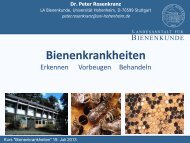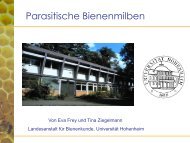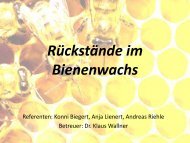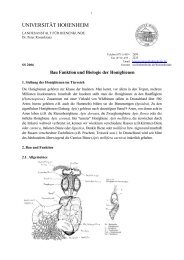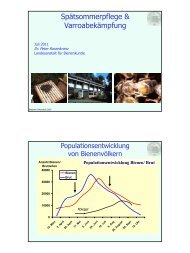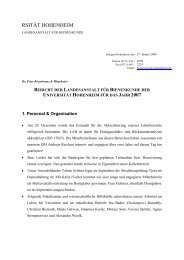Nosema ceranae in European honey bees - Landesanstalt für ...
Nosema ceranae in European honey bees - Landesanstalt für ...
Nosema ceranae in European honey bees - Landesanstalt für ...
You also want an ePaper? Increase the reach of your titles
YUMPU automatically turns print PDFs into web optimized ePapers that Google loves.
S74 I. Fries / Journal of Invertebrate Pathology 103 (2010) S73–S79<br />
put N. apis closer to N. bombi than to N. <strong>ceranae</strong>. In the most recent<br />
attempt to compile a phylogeny of microsporidians <strong>in</strong>fect<strong>in</strong>g <strong>bees</strong>,<br />
Shafer et al. (2009) used multiple sequence data sets, rather than<br />
sequences for a s<strong>in</strong>gle gene, and concluded that N. <strong>ceranae</strong> is a sister<br />
species to N. bombi and that N. apis is the basal member of the<br />
clade. Based on their analysis, they (Shafer et al., 2009) suggest that<br />
either an ancestral N. bombi switched host from a Bombus l<strong>in</strong>eage<br />
to A. cerana, or an ancestral N. <strong>ceranae</strong> switched host to Bombus.<br />
Chen et al. (2009) sequenced the DNA of the rRNA gene from N.<br />
<strong>ceranae</strong> and found the size to be 4475 bp, slightly larger than reported<br />
by Huang et al. (2007). The GC content of the 16S SSU-rRNA<br />
cistron is approximately 36% (Huang et al., 2007; Chen et al., 2009).<br />
The <strong>in</strong>ternal transcribed spacer (ITS) region consists of a 39-bp sequence<br />
and is located between nucleotides 1260 and 1298 (Huang<br />
et al., 2007; Chen et al., 2009).<br />
The use of sequence similarities <strong>in</strong> the conserved rRNA gene is<br />
common for build<strong>in</strong>g phylogenies among eukaryotes. In the case<br />
of microsporidian parasites this strategy may not be optimal. The<br />
presence of multiple copies of rRNA is common <strong>in</strong> Microsporidia<br />
(Gatehouse and Malone, 1998; Tay et al., 2005) possibly represent<strong>in</strong>g<br />
a case of concerted evolution, the duplication of entire loci<br />
with<strong>in</strong> a genome. However, analyz<strong>in</strong>g the rRNA gene from a s<strong>in</strong>gle<br />
spore of N. bombi, O’Mahony et al., 2007 demonstrated multiple<br />
copies of rRNA which were not all homologous. Multiple nonhomologous<br />
copies of rRNA may be a common feature of<br />
Microsporidia. Thus, homologs cannot be compared between isolates,<br />
which reduces the utility of the rRNA genes of microsporidians<br />
for phylogenetic analysis (O’Mahony et al., 2007). For future<br />
attempts to study N. <strong>ceranae</strong> phylogeny, there is a need to develop<br />
s<strong>in</strong>gle-locus polymorphic markers (O’Mahony et al., 2007).<br />
Based on pyrosequenc<strong>in</strong>g data, a draft assembly of the N. <strong>ceranae</strong><br />
genome (7.86 MB) has recently been presented (Cornman et al.,<br />
2009). The genome of N. <strong>ceranae</strong> is extremely reduced and strongly<br />
AT-biased (74% A + T) (Cornman et al., 2009). Polymorphism among<br />
rRNA loci, as reported for N. bombi (O’Mahony et al., 2007) is likely to<br />
occur also <strong>in</strong> N. <strong>ceranae</strong>, which complicates the genome assembly of<br />
this operon (Cornman et al., 2009). The genome analysis predicts<br />
2614 prote<strong>in</strong>-cod<strong>in</strong>g sequences, arguably an underestimate s<strong>in</strong>ce a<br />
fraction of the genome likely did not assemble <strong>in</strong> this draft project<br />
(ca. 5–10%). About 50% of the predicted prote<strong>in</strong>-cod<strong>in</strong>g sequences<br />
<strong>in</strong> the N. <strong>ceranae</strong> genome share significant similarity with the microsporidian<br />
Encephalitozoon cuniculi, so far the most closely related<br />
published genome sequence Cornman et al., 2009). Interest<strong>in</strong>gly,<br />
both parasites appear to differ from yeast and other fungi by us<strong>in</strong>g<br />
a larger fraction of the genome for growth related gene categories<br />
and a reduced fraction to transport and to chemical stimuli (Cornman<br />
et al., 2009). This is likely to reflect the extreme parasitic life<br />
form represented by microsporidians. Many aspects of the <strong>Nosema</strong>-<strong>honey</strong><br />
bee <strong>in</strong>teractions rema<strong>in</strong> enigmatic. Identification of genes<br />
with specific functions is a first step <strong>in</strong> resolv<strong>in</strong>g such host–parasite<br />
<strong>in</strong>teractions at the gene level. Cornman et al. (2009) stress the 89<br />
gene models encod<strong>in</strong>g signal peptides as be<strong>in</strong>g of particular <strong>in</strong>terest<br />
because these prote<strong>in</strong>s are candidate secretory prote<strong>in</strong>s that may<br />
<strong>in</strong>teract with host tissue. Antúnez et al. (2009) attempted to measure<br />
gene responses follow<strong>in</strong>g microsporidia <strong>in</strong>fections. Their results<br />
suggest differences <strong>in</strong> upregulation of genes encod<strong>in</strong>g the antibacterial<br />
peptides abaec<strong>in</strong>, defens<strong>in</strong> and hymenoptaec<strong>in</strong> between <strong>in</strong>fections<br />
with N. <strong>ceranae</strong> and N. apis. However, previous work based on<br />
antibacterial properties of hemolymph from N. apis <strong>in</strong>fected <strong>bees</strong><br />
did not show any antibacterial effects from such hemolymph (Craig<br />
et al., 1989). The results of Antúnez et al. (2009) are <strong>in</strong>terest<strong>in</strong>g, because<br />
they also suggest that immuno suppression results from N. <strong>ceranae</strong><br />
<strong>in</strong>fections. Given that their study (Antúnez et al., 2009) <strong>in</strong>cludes<br />
time limited data only, it is premature to conclude that the gene<br />
expression data available are <strong>in</strong>dicative of variations <strong>in</strong> virulence between<br />
N. <strong>ceranae</strong> and N. apis.<br />
3. Distribution<br />
Although <strong>in</strong>fective for A. mellifera, N. <strong>ceranae</strong> was previously believed<br />
to be geographically limited to the natural distribution area<br />
of A. cerana (Fries, 1997). However, Huang et al. (2008) sequenced<br />
rRNA spacer regions <strong>in</strong> N. <strong>ceranae</strong> samples from both <strong>honey</strong> bee<br />
host species and found little or no differences between samples,<br />
suggest<strong>in</strong>g that no transmission barrier exists for N. <strong>ceranae</strong> between<br />
A. mellifera and A. cerana. Based on historical data (Klee<br />
et al., 2007), it appears likely that N. <strong>ceranae</strong> has entered <strong>in</strong>to a<br />
new host (from A. cerana <strong>in</strong>to A. mellifera), and is presently spread<strong>in</strong>g<br />
with<strong>in</strong> that species, although this scenario still needs to be confirmed.<br />
Thus, we do not know when or where this proposed host<br />
shift may have occurred. In the US there are confirmed <strong>in</strong>fections<br />
of N. <strong>ceranae</strong> dat<strong>in</strong>g back to the mid-1990s (Chen et al., 2008)<br />
and <strong>in</strong> Uruguay one sample pre-dat<strong>in</strong>g 1990 has been confirmed<br />
to conta<strong>in</strong> N. <strong>ceranae</strong> (Invernizzia et al., 2009), which is the oldest<br />
record of N. <strong>ceranae</strong> <strong>in</strong> A. mellifera.<br />
Analysis of samples from all cont<strong>in</strong>ents where apiculture is practiced<br />
demonstrate that N. <strong>ceranae</strong> <strong>in</strong>fections of A. mellifera occur<br />
worldwide (Klee et al., 2007; Giersch et al., 2009) but is so far only<br />
detected <strong>in</strong> North Africa (Higes et al., 2009). However, it appears<br />
from historical records that N. <strong>ceranae</strong> <strong>in</strong>fections progressively have<br />
become more common over time, at least <strong>in</strong> some regions (Klee et al.,<br />
2007; Paxton et al., 2007). In F<strong>in</strong>land analysis of ten year old bee samples<br />
demonstrated only <strong>in</strong>fections of N. apis, whereas more recent<br />
samples conta<strong>in</strong>ed mixed samples of N. apis and N. <strong>ceranae</strong> or pure<br />
<strong>in</strong>fections of N. <strong>ceranae</strong> (Paxton et al., 2007). There data were <strong>in</strong>terpreted<br />
as the process of one parasite possibly replac<strong>in</strong>g the other<br />
(Paxton et al., 2007). If their is a general tendency for N. <strong>ceranae</strong><br />
replac<strong>in</strong>g N. apis this will be evident as more data on microsporidia<br />
<strong>in</strong>fections <strong>in</strong> <strong>honey</strong> <strong>bees</strong> become available. Data from the German<br />
bee monitor<strong>in</strong>g project, for which both <strong>Nosema</strong> species were dist<strong>in</strong>guished,<br />
does not yet suggest that one parasite is replac<strong>in</strong>g the other<br />
(Monitor<strong>in</strong>g-Projekt ‘‘Völkerverluste”, 2008). A national survey for<br />
microsporidia <strong>in</strong>fections <strong>in</strong> Sweden, us<strong>in</strong>g species specific molecular<br />
detection techniques to dist<strong>in</strong>guish between N. apis and N. <strong>ceranae</strong>,<br />
demonstrated no pure <strong>in</strong>fections of N. <strong>ceranae</strong>, but only mixed <strong>in</strong>fections<br />
(17%) and pure N. apis <strong>in</strong>fections (83%) <strong>in</strong> 319 samples positive<br />
for microsporidia <strong>in</strong> light microscopy (Fries and Forsgren, 2008). Later<br />
surveys will document if the proportion of N. <strong>ceranae</strong> will <strong>in</strong>crease<br />
over time.<br />
Both on the North American cont<strong>in</strong>ent (Williams et al., 2008)<br />
and <strong>in</strong> Europe (Martín-Hernández et al., 2007; Fries and Forsgren,<br />
2008) the proportion of N. <strong>ceranae</strong> <strong>in</strong>fections appears to dom<strong>in</strong>ate<br />
<strong>in</strong> warmer climates compared to more temperate regions, whereas<br />
N. apis presently may be more prevalent <strong>in</strong> colder climates. It is unclear<br />
whether this difference <strong>in</strong> prevalence from north to south reflects<br />
the direction of spread. In F<strong>in</strong>land the prevalence of N.<br />
<strong>ceranae</strong> is much higher compared to Sweden and Norway (Paxton<br />
et al., 2007; Fries and Forsgren, 2008) although the climates are<br />
similar. One difference between these countries is that F<strong>in</strong>land<br />
imports <strong>bees</strong> from southern Europe, where the prevalence of<br />
N. <strong>ceranae</strong> is high, whereas Sweden and Norway have not imported<br />
<strong>bees</strong> from areas with N. <strong>ceranae</strong> <strong>in</strong> recent years. Nevertheless,<br />
climate may be an important factor expla<strong>in</strong><strong>in</strong>g differences <strong>in</strong><br />
species distribution and impact. Us<strong>in</strong>g both N. <strong>ceranae</strong> and N. apis<br />
spores, Martín-Hernández et al., 2009 compared the <strong>in</strong>crease <strong>in</strong><br />
spore numbers <strong>in</strong> <strong>in</strong>dividual bee abdomens at different times post<br />
<strong>in</strong>fection and found N. <strong>ceranae</strong> to <strong>in</strong>crease more <strong>in</strong> numbers over a<br />
wider temperature range compared to N. apis. It is not yet clear<br />
how this difference may <strong>in</strong>fluence the distribution of N. <strong>ceranae</strong>.<br />
The viability of N. <strong>ceranae</strong> spores is significantly reduced follow<strong>in</strong>g<br />
one week <strong>in</strong> a deep freezer, which is not the case for N. apis<br />
(Fries and Forsgren, 2009). This difference <strong>in</strong> temperature sensitivity<br />
between parasite species probably has epidemiological



